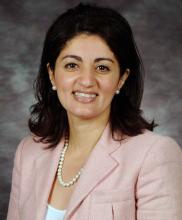, but, as with any emergent technology, pitfalls come along with the promise and potential.
Meanwhile, technology to remotely monitor respiratory diseases is advancing into other modalities. In recent months, researchers have reported on an artificial intelligence–aided home stethoscope to monitor asthma exacerbations and an ingestible electronic capsule, which has shown some facility for continuous, remote monitoring of sleep apnea and opioid induced respiratory depression.
“Smartphones and wearable technology in health care are here to stay,” Mariam Louis, MD, pulmonologist and sleep medicine physician at the University of Florida Health and chair of the nonrespiratory sleep section of the Sleep Medicine Network with the American College of Chest Physicians, said in an interview.
“It is an exciting field, as it encourages patients to be actively involved in their medical care and can potentially offer more real-time feedback regarding the patient’s medical conditions,” she said. “There are currently many apps that are being used to monitor sleep and other diseases. However, the technology is still rudimentary, and much more research is needed to see if these apps are accurate and dependable.”
Studies in the past few months have reported on the accuracy of 18 wearable sleep-tracker devices, finding they overestimated sleep duration by 19 minutes on average (Sleep. 2023 Nov 8. doi: 10.1093/sleep/zsad288). Researchers in the United States also recently reported on the first human trial of an ingestible pill for monitoring sleep apnea that sends data to a receiving device up to six feet away (Device. 2023 Nov 17. doi: 10.1016/j.device.2023.100125), and a group in Poland reported than an AI-aided home stethoscope provided reliable information on asthma exacerbations in 149 patients (Ann Fam Med. 2023;21:517-25).
Targeting Challenges With Polysomnography
All of these technologies aim to overcome challenges with traditional devices, such as polysomnography (PSG) for evaluating sleep. Jaques Reifman, PhD, a senior research scientist at the U.S. Army Medical Research and Development Command in Fort Detrick, Maryland, led the study of 18 wearable sleep trackers. “Both polysomnography and sleep tracking devices in a sense are attempting to reach the same goal: they’re trying to estimate certain sleep parameters,” Dr. Reifman said in an interview.
“But they use very different signals,” he added, noting that PSG uses electroencephalography (EEG) to measure electrical signals in the skull whereas most sleep trackers used an accelerometer to measure body movement. “As your wrist moves around, it determines if you are moving or not,” Dr. Reifman said.
“Each of them have their plusses and minuses,” he added. PSG, while it’s considered the gold standard for measuring sleep, isn’t a consumer product. “It generally requires a very sophisticated data acquisition system; they are laden with motion artifacts and you have to have software to remove them before you analyze the data,” Dr. Reifman said. “They generally require an expert to interpret the results, although lately there are a few AI-based algorithms that you can provide the EEG signals to and it does score those stages for you”
Sleep trackers, on the other hand, are consumer products. “They can be used outside the lab, and you can use them to record for long periods of time, which is not really possible with PSG,” Dr. Reifman said. “They are low cost, they are easy to use, small size, and folks have developed algorithms that can directly tell the consumer you slept seven hours last night.
“In that sense, they’re comfortable to use as opposed to using an almost-like shower cap with the EEG and face sensors as part of the PSG montage.”
However, what sleep trackers offer in convenience, they lack in accuracy. “There are things they just cannot do based on the limitations of the signals that they use,” Dr. Reifman said.
The study was actually a meta-analysis of 14 different studies that evaluated 18 different sleep-tracking devices in 364 patients. The meta-analysis found wide variability in accuracy between devices; for example, a 75-minute overestimation of sleep with one device and a one-minute overestimation with another.
And different studies reported variations with the same tracker or different models of a tracker. The Fitbit Charge 2, for example, was found to underestimate sleep by 12 minutes in one study and overestimate sleep by 9 minutes in another, while the Fitbit HR Charge was found to overestimate sleep by 52 minutes in a third study.
The meta-analysis found while sleep trackers have high sensitivity (>90%), they had a relatively low specificity (<50%), Dr. Reifman noted.
“Because they are mainly based on the acceleration of your wrist, if you are laying down in bed and motionless after a few minutes the device is going to think you’re asleep when in reality you’re just motionless, daydreaming or trying to go to sleep but not sleeping, so the specificity to sleep is not that high,” he said.
These types of devices still have obstacles to overcome before they’re more widely used, Dr. Louis said. “All of these technologies are proprietary,” she said. “As such, little is known about the algorithms used to come up with the diagnosis or other conclusions. In addition, the majority of the data cannot be analyzed independently by the providers, limiting some of the usage of these devices for now.”


